
Copyright © May, 2010, Revised August, 2011 (TS) For Machines Mfg. Since 8/09
MODEL SB1020
OWNER'S MANUAL
9" x 12" HORIZONTAL VARIABLE SPEED
METAL-CUTTING BANDSAW
WITH SLIDING VISE

Customer Service
We stand behind our machines. If you have any service questions, parts requests or general questions
about the machine, feel free to contact us.
South Bend Lathe Co.
P.O. Box 2027
Bellingham, WA 98227
Phone: (360) 734-1540
Parts Department: (417) 886-2954
Fax: (360) 676-1075 (International)
Fax: (360) 734-1639 (USA Only)
Email: [email protected]
Updates
For your convenience, any updates to this manual will be available to download free of charge
through our website at:
www.southbendlathe.com
Scope of Manual
This manual helps the reader understand the machine, how to prepare it for operation, how to control
it during operation, and how to keep it in good working condition. We assume the reader has a basic
understanding of how to operate this type of machine, but that the reader is not familiar with the
controls and adjustments of this specific model. As with all machinery of this nature, learning the
nuances of operation is a process that happens through training and experience. If you are not an
experienced operator of this type of machinery, read through this entire manual, then learn more
from an experienced operator, schooling, or research before attempting operations. Following this
advice will help you avoid serious personal injury and get the best results from your work.
Manual Feedback
We've made every effort to be accurate when documenting this machine. However, errors sometimes
happen or the machine design changes after the documentation process—so
the manual may not
exactly match your machine.
If a difference between the manual and machine leaves you in doubt,
contact our
customer service for clarification.
We highly value customer feedback on our manuals. If you have a moment, please share your
experience using this manual. What did you like about it? Is there anything you would change to
make it better? Did it meet your expectations for clarity, professionalism, and ease-of-use?
South Bend Lathe, Inc.
C
/O Technical Documentation Manager

Table of Contents
MAINTENANCE ............................................................. 31
Maintenance Schedule .......................................31
Cleaning .............................................................31
Lubrication ......................................................... 31
Machine Storage ................................................32
TROUBLESHOOTING ................................................. 33
SERVICE...........................................................................36
Blade Brush........................................................36
Angle Stops.........................................................36
Limit Switches ...................................................37
Downfeed Stop Bolt ...........................................38
Squaring Blade ..................................................39
ELECTRICAL ................................................................... 40
Electrical Safety Instructions ...........................40
220V Conversion ................................................41
Electrical Box Wiring Diagram ......................... 43
Components Wiring Diagram ...........................44
Wiring Component Locations ............................45
PARTS................................................................................46
Cabinet & Base ..................................................46
Head ...................................................................48
Control Box.........................................................51
Machine Labels ..................................................52
WARRANTY & RETURNS .......................................... 53
INTRODUCTION ............................................................... 2
About This Machine .............................................2
Identification ........................................................ 3
Machine Specifications ........................................4
SAFETY ................................................................................6
Understanding Risks of Machinery ....................6
Basic Machine Safety ..........................................6
Additional Metal Bandsaw Safety ......................8
PREPARATION .................................................................9
Preparation Overview ..........................................9
Things You'll Need ...............................................9
Power Supply Requirements ............................... 9
Unpacking ..........................................................11
Inventory ............................................................11
Cleaning & Protecting .......................................12
Location ..............................................................13
Lifting & Moving ................................................14
Leveling & Mounting .........................................14
Power Connection ..............................................16
Machine Setup ...................................................16
Test Run .............................................................17
Inspections & Adjustments ...............................17
OPERATION .................................................................... 18
Operation Overview ...........................................18
Description of Controls & Components ............19
Blade Selection ...................................................20
Blade Changes ...................................................23
Blade Tension .....................................................24
Blade Breakage .................................................. 24
Blade Care & Break-In ......................................25
Downfeed Rate ...................................................25
Downfeed Pressure ............................................25
Blade Speed Chart ............................................. 26
Chip Inspection Chart .......................................26
Angle Cuts ..........................................................27
Work Stop ...........................................................27
Blade Guide ........................................................28
Vise Quick Release.............................................28
Workpiece Holding .............................................28
Cutting Fluid ......................................................29
Cutting Fluid System ........................................29
Operation Tips ...................................................30

INTRODUCTION
-2-
For Machines Mfg. Since 8/09
Model SB1020
INTRODUCTION
About This Machine
Capabilities
This metal cutting bandsaw uses a gravity-fed
blade to make straight cuts through workpieces
that are clamped in a vise. Since the workpiece is
secured and remains stationary while the blade
lowers automatically, accuracy and operator
safety are maximized.
The vise on the Model SB1020 is capable of
holding rectangular stock up to 9" x 12" and
round stock up to 10".
After a cut is complete, the OFF switch is
triggered and the motor automatically turns off.
Features
In addition to its capabilities, the Model SB1020
has several features to increase versatility and
efficiency.
The headstock can be rotated to make angled
cuts from -45°–60° while variable blade speeds
ensure that the proper cutting speed is available
for a variety of workpiece sizes and materials.
Both the downfeed rate and pressure are
adjustable for fine-tuning each cutting operation
and an adjustable auto-OFF power switch
maximizes safety and minimizes energy use by
turning the machine off at the end of every cut.
A flood coolant system, comprised of a coolant
tank and pump in the machine base and an
adjustable nozzle at the blade provide adequate
coolant for optimum cutting efficiency and blade
life.
A storage compartment in the cabinet base
provides a convenient location for keeping spare
blades or other accessories and the transport
handle makes moving the machine easy.

For Machines Mfg. Since 8/09 Model SB1020
-3-
INTRODUCTION
Identification
Serious personal injury could occur if
you connect the machine to power before
completing the setup process. DO NOT
connect power until instructed to do so later
in this manual.
Untrained users have an increased risk
of seriously injuring themselves with this
machine. Do not operate this machine until
you have understood this entire manual and
received proper training.
Front View
Rear View
Blade Tension
Knob
Downfeed
Controls
Motor
Control Panel
Coolant
Valve
Blade
Vise
Vise
Handwheel
Cabinet Access
Door
Downfeed
Ram
Figure 1. Identification.
Headstock
Headstock
Vise Quick
Release
Vise Slide
Lock
Swivel Lock
Handle
Work Stop
Blade
Cover

-4-
For Machines Mfg. Since 8/09
Model SB1020
INTRODUCTION
Machine Specifications
Model SB1020
Page 1 of 3
Model SB1020
9" x 12" Horizontal, Variable Speed Metal-
cutting Bandsaw with Sliding Vise!
Product Dimensions
Weight............................................................................................................................................................. 718 lbs.
Width (side-to-side) x Depth (front-to-back) x Height...................................................
55-1/8 x 27-1/2 x 60-5/8 in.
Footprint (Length x Width)...........................................................................................................
27-1/2 x 60-5/8 in.
Space Required for Full Range of Movement (Width x Depth)............................................................... 65 x 47 in.
Shipping Dimensions
Type.................................................................................................................................................. Wood Slat Crate
Content.......................................................................................................................................................... Machine
Weight.............................................................................................................................................................
846 lbs.
Length x Width x Height...................................................................................................................
32 x 56 x 68 in.
Electrical
Power Requirement........................................................................................... 110V or 220V, Single-Phase, 60 Hz
Prewired Voltage................................................................................................................................................ 110V
Full-Load Current Rating.................................................................................................... 6A at 110V, 3A at 220V
Minimum Circuit Size.....................................................................................................
20A at 110V, 15A at 220V
Connection Type.....................................................................................................................................
Cord & Plug
Power Cord Included............................................................................................................................................. Yes
Power Cord Length....................................................................................................................................... 11-1/2 ft.
Power Cord Gauge......................................................................................................................................... 14 AWG
Plug Included........................................................................................................................................................
Yes
Included Plug Type...............................................................................................................................
5-15 for 110V
Recommended Plug Type..................................................................................................................... 6-15 for 220V
Switch Type....................................................................................... Control Panel w/Magnetic Switch Protection
Voltage Conversion Kit........................................................................................................... PSB1020511 for 220V
Motors
Main
Type........................................................................................................................................
TEFC Induction
Horsepower............................................................................................................................................
1.5 HP
Phase.................................................................................................................................................... 3-Phase
Amps.......................................................................................................................................................... 5.1A
Speed................................................................................................................................................ 1725 RPM
Power Transfer ...................................................................................................................
Worm Gear Drive
Bearings................................................................................................
Shielded & Permanently Lubricated

For Machines Mfg. Since 8/09 Model SB1020
-5-
INTRODUCTION
Model SB1020
Page 2 of 3
Coolant Pump
Type............................................................................................................. TEFC Capacitor-Start Induction
Horsepower............................................................................................................................................ 1/8 HP
Phase............................................................................................................................................
Single-Phase
Amps................................................................................................................................................
0.9A/0.45A
Speed................................................................................................................................................ 3450 RPM
Bearings.................................................................................................... Sealed & Permanently Lubricated
Main Specifications
Operation Info
Blade Speeds................................................................................................................................ 92–360 FPM
Std. Blade Length............................................................................................................................
108-1/4 in.
Blade Size Range..........................................................................................................................
1 - 1-1/16 in.
Head Swivel.......................................................................................................................... -45 deg to 60 deg.
Cutting Capacities
Angle Cuts................................................................................................................................... -45 to 60 deg.
Vise Jaw Depth.................................................................................................................................. 12-5/8 in.
Vise Jaw Height...................................................................................................................................
5-1/2 in.
Max. Capacity Rectangular Height at 90 Deg.........................................................................................
9 in.
Max. Capacity Rectangular Width at 90 Deg......................................................................................... 12 in.
Max. Capacity Round at 90 Deg............................................................................................................. 10 in.
Max. Capacity Rectangular Height at 45 Deg................................................................................... 4-3/4 in.
Max. Capacity Rectangular Width at 45 Deg...........................................................................................
7 in.
Max. Capacity Round at 45 Deg.........................................................................................................
7-7/8 in.
Max. Capacity Rectangular Height at 60 Deg................................................................................... 4-1/2 in.
Max. Capacity Rectangular Width at 60 Deg.................................................................................... 6-1/8 in.
Max. Capacity Round at 60 Deg......................................................................................................... 4-1/2 in.
Max. Capacity Rectangular Height at -45 Deg..................................................................................
4-3/4 in.
Max. Capacity Rectangular Width at -45 Deg.........................................................................................
7 in.
Max. Capacity Round at -45 Deg........................................................................................................ 6-3/4 in.
Construction
Upper Wheel...................................................................................................................................... Cast Iron
Lower Wheel...................................................................................................................................... Cast Iron
Body...................................................................................................................................................
Cast Iron
Base....................................................................................................................................................
Cast Iron
Stand......................................................................................................................................................... Steel
Other
Wheel Size.......................................................................................................................................... 12-5/8 in.
Blade Guides Upper.................................................................................................................................... Yes
Blade Guides Lower....................................................................................................................................
Yes
Coolant Cap.......................................................................................................................................
2-1/2 Gal.
Table Info
Floor To Cutting Area Height........................................................................................................... 35-5/8 in.
Other
Country Of Origin .......................................................................................................................................... Taiwan
Warranty ......................................................................................................................................................... 1 Year
Approximate Assembly & Setup Time .......................................................................................................... 1 Hour
Serial Number Location .................................................................................................... ID Label on Body Frame
Sound Rating .................................................................................................................................................... 80 dB
ISO 9001 Factory ................................................................................................................................................. Yes
CSA Certified ......................................................................................................................................................... No

SAFETY
-6-
For Machines Mfg. Since 8/09
Model SB1020
SAFETY
Understanding Risks of Machinery
Operating all machinery and machining equipment can be dangerous or relatively safe depending
on how it is installed and maintained, and the operator's experience, common sense, risk awareness,
working conditions, and use of personal protective equipment (safety glasses, respirators, etc.).
The owner of this machinery or equipment is ultimately responsible for its safe use. This
responsibility includes proper installation in a safe environment, personnel training and usage
authorization, regular inspection and maintenance, manual availability and comprehension,
application of safety devices, integrity of cutting tools or accessories, and the usage of approved
personal protective equipment by all operators and bystanders.
The manufacturer of this machinery or equipment will not be held liable for injury or property
damage from negligence, improper training, machine modifications, or misuse. Failure to read,
understand, and follow the manual and safety labels may result in serious personal injury, including
amputation, broken bones, electrocution, or death.
The signals used in this manual to identify hazard levels are as follows:
Death or catastrophic
harm WILL occur.
Moderate injury or fire
MAY occur.
Death or catastrophic
harm COULD occur.
Machine or property
damage may occur.
Basic Machine Safety
Owner’s Manual: All machinery and machining
equipment presents serious injury hazards
to untrained users. To reduce the risk of
injury, anyone who uses THIS item MUST
read and understand this entire manual
before starting.
Personal Protective Equipment:
Operating or
servicing this item may expose the user
to flying debris, dust, smoke, dangerous
chemicals, or loud noises. These hazards
can result in eye injury, blindness, long-
term respiratory damage, poisoning,
cancer, reproductive harm or hearing loss.
Reduce your risks from these hazards
by wearing approved eye protection,
respirator, gloves, or hearing protection.
Trained/Supervised Operators Only: Untrained
users can seriously injure themselves
or bystanders. Only allow trained and
properly supervised personnel to operate
this item. Make sure safe operation
instructions are clearly understood. If
electrically powered, use padlocks and
master switches, and remove start switch
keys to prevent unauthorized use or
accidental starting.
Guards/Covers:
Accidental contact with
moving parts during operation may cause
severe entanglement, impact, cutting,
or crushing injuries. Reduce this risk by
keeping any included guards/covers/doors
installed, fully functional, and positioned
for maximum protection.

For Machines Mfg. Since 8/09 Model SB1020
-7-
SAFETY
Entanglement: Loose clothing, gloves, neckties,
jewelry or long hair may get caught in
moving parts, causing entanglement,
amputation, crushing, or strangulation.
Reduce this risk by removing/securing
these items so they cannot contact moving
parts.
Mental Alertness: Operating this item with
reduced mental alertness increases the
risk of accidental injury. Do not let a
temporary influence or distraction lead to a
permanent disability! Never operate when
under the influence of drugs/alcohol, when
tired, or otherwise distracted.
Safe Environment:
Operating electrically
powered equipment in a wet environment
may result in electrocution; operating near
highly flammable materials may result in a
fire or explosion. Only operate this item in
a dry location that is free from flammable
materials.
Electrical Connection: With electically powered
equipment, improper connections to the
power source may result in electrocution
or fire. Always adhere to all electrical
requirements and applicable codes when
connecting to the power source. Have all
work inspected by a qualified electrician to
minimize risk.
Disconnect Power: Adjusting or servicing
electrically powered equipment while it
is connected to the power source greatly
increases the risk of injury from accidental
startup. Always disconnect power
BEFORE any service or adjustments,
including changing blades or other tooling.
Secure Workpiece/Tooling:
Loose workpieces,
cutting tools, or rotating spindles can
become dangerous projectiles if not
secured or if they hit another object during
operation. Reduce the risk of this hazard
by verifying that all fastening devices are
properly secured and items attached to
spindles have enough clearance to safely
rotate.
Chuck Keys or Adjusting Tools:
Tools used to
adjust spindles, chucks, or any moving/
rotating parts will become dangerous
projectiles if left in place when the machine
is started. Reduce this risk by developing
the habit of always removing these tools
immediately after using them.
Work Area:
Clutter and dark shadows increase
the risks of accidental injury. Only operate
this item in a clean, non-glaring, and well-
lighted work area.
Properly Functioning Equipment:
Poorly
maintained, damaged, or malfunctioning
equipment has higher risks of causing
serious personal injury compared to
those that are properly maintained.
To reduce this risk, always maintain
this item to the highest standards and
promptly repair/service a damaged or
malfunctioning component. Always follow
the maintenance instructions included in
this documentation.
Unattended Operation:
Electrically powered
equipment that is left unattended while
running cannot be controlled and is
dangerous to bystanders. Always turn the
power OFF before walking away.
Health Hazards: Certain cutting fluids and
lubricants, or dust/smoke created when
cutting, may contain chemicals known to
the State of California to cause cancer,
respiratory problems, birth defects,
or other reproductive harm. Minimize
exposure to these chemicals by wearing
approved personal protective equipment
and operating in a well ventilated area.
Difficult Operations:
Attempting difficult
operations with which you are unfamiliar
increases the risk of injury. If you
experience difficulties performing the
intended operation, STOP! Seek an
alternative method to accomplish the
same task, ask a qualified expert how the
operation should be performed, or contact
our Technical Support for assistance.

-8-
For Machines Mfg. Since 8/09
Model SB1020
SAFETY
Additional Metal Bandsaw Safety
1. Blade Condition. A dull or damaged
blade can break apart during operation,
increasing the risk of operator injury. Do
not operate with a dull, cracked or badly
worn blade. Inspect the blade for cracks or
missing teeth before each use.
2. Hand Placement. Hands could be cut
by the blade or crushed when lowering
the headstock. Never position fingers or
thumbs in line with the cut or under the
headstock while it is moving.
3. Blade Guard. Hands and fingers can easily
be cut by the bandsaw blade. To reduce the
risk of laceration injuries, do not operate
this bandsaw without the blade guard in
place.
4. Starting Position. To reduce the
likelihood of blade breakage and possible
entanglement, never turn the saw ON
with the blade resting on the workpiece.
5. Blade Replacement. The blade can only
make a safe and efficient cut if the teeth
are facing the workpiece. When replacing
blades, make sure the teeth face toward
the workpiece. Wear gloves to protect
hands and safety glasses to protect eyes.
6. Workpiece Handling. A shifting workpiece
can result in impact or laceration injuries.
To reduce the risk of injury, always securely
clamp the workpiece in the vise and use
additional support fixtures if needed. Never
hold the workpiece with your hands during
a cut. Flag long pieces to reduce the risk of
tripping over them.
7. Power Interruption. Unplug the machine
and turn the power switch OFF after a
power interruption. If left plugged in and
turned ON, this machine will start up when
power is restored, resulting in possible
entanglement, laceration, or amputation
hazards.
8. Hot Surfaces/Sharp Edges. Due to the
cutting process, a freshly cut workpiece,
chips, and some machine components can be
hot enough to burn you and sharp enough to
cut you. Allow components to cool and use
safe handling methods to reduce the risk of
these injuries.
9. Moving Blade. A moving bandsaw blade
presents a serious risk for laceration or
amputation injuries. Always allow the blade
to come to a complete stop before mounting
or repositioning a workpiece in the vise.
Never touch a moving blade.

PREPARATION
For Machines Mfg. Since 8/09 Model SB1020
-9-
PRE PARATION
Preparation Overview
The purpose of the preparation section is to help
you prepare your machine for operation. The
list below outlines the basic process to follow
to prepare your machine for operation. Specific
steps for each of these points will be covered in
detail later in this section.
The typical preparation process is as follows:
1. Unpack the machine and inventory the
contents of the carton.
2. Clean the machine and its components.
3. Make any necessary adjustments or
inspections to ensure the machine is ready
for operation.
4. Connect the machine to the power source.
5. Test run the machine to make sure it
functions properly and is ready for operation.
The items listed below are required to
successfully set up and prepare this machine for
operation.
For Lifting
• A forklift or other power lifting device rated
for the weight of the machine.
• Lifting Straps or Chains (rated for at least
1000 lbs. each)
For Machine Setup
• Wrench 12mm
• Wrench 14mm
For Power Connection
• A power source that meets the minimum
circuit requirements for this machine. (Refer
to the Power Supply Requirements
section for details.)
• A qualified electrician to ensure a safe and
code-compliant connection to the power
source.
Things You'll Need
Power Supply
Requirements
Electrocution or fire may
occur if machine is not
correctly grounded and
attached to the power
supply. Use a qualified
electrician to ensure a safe
power connection.
Before installing the machine, consider the
availability and proximity of the required power
supply circuit. If an existing circuit does not meet
the requirements for this machine, a new circuit
must be installed.
To minimize the risk of electrocution, fire,
or equipment damage, installation work and
electrical wiring must be done by a
n electrician
or qualified service personnel
in accordance with
applicable electrical codes and safety standards.
Availability
The full-load current rating is the amperage
a machine draws at 100% of the rated output
power. On machines with multiple motors, this is
the amperage drawn by the largest motor or sum
of all motors and electrical devices that might
operate at one time during normal operations.
The full-load current is not the maximum
amount of amps that the machine will draw. If
the machine is overloaded, it will draw additional
amps beyond the full-load rating.
If the machine is overloaded for a sufficient
length of time, damage, overheating, or fire may
result—especially if connected to an undersized
circuit. To reduce the risk of these hazards,
avoid overloading the machine during operation
and make sure it is connected to a power supply
circuit that meets the requirements in the
following section.
Full-Load Current Rating
Full-Load Rating at 110V ................... 18 Amps
Full-Load Rating at 220V ..................... 9 Amps

-10-
For Machines Mfg. Since 8/09
Model SB1020
PRE PARATION
For your own safety and protection of property,
consult an electrician if you are unsure about
wiring practices or applicable electrical codes.
A power supply circuit includes all electrical
equipment between the main breaker box or fuse
panel in your building and the incoming power
connections inside the machine. This circuit
must be safely sized to handle the full-load
current that may be drawn from the machine for
an extended period of time. (If this machine is
connected to a circuit protected by fuses, use a
time delay fuse marked D.)
Circuit Information
Circuit Requirements for 110V
This machine is prewired to operate on a 110V
power supply circuit that has a verified ground
and meets the following requirements:
Nominal Voltage ............................... 110V/120V
Cycle .............................................................60 Hz
Phase ..............................................Single-Phase
Circuit Rating....................................... 20 Amps
Plug/Receptacle (included) ...........NEMA 5-15
Note: The circuit requirements in this manual
are for
a dedicated circuit—where only one
machine will be running at a time. If this
machine will be connected to a shared circuit
where multiple machines will be running at
the same time, consult a qualified electrician to
ensure the circuit is properly sized.
Circuit Requirements for 220V
Nominal Voltage ............................... 220V/240V
Cycle .............................................................60 Hz
Phase ..............................................Single-Phase
Circuit Rating....................................... 15 Amps
Plug/Receptacle ...............................NEMA 6-15
This machine can be converted to operate on
a 220V power supply. To do this, follow the
Voltage Conversion
instructions included in
this
manual. The intended 220V circuit must
have a verified ground and meet the
following
requirements:
Grounding Requirements
This machine must be grounded! In the event
of
certain types of malfunctions or breakdowns,
grounding provides a path of least resistance
for electric current in order to reduce the risk of
electric shock.
Grounding Prong
Current Carrying Prongs
5-15 PLUG
GROUNDED
5-15 RECEPTACLE
Figure 2. NEMA 5-15 plug and receptacle.
This machine is equipped with a power cord
that has
an equipment-grounding wire and a
grounding plug
(similar to the figure below).
The plug
must only be inserted into a matching
receptacle (outlet)
that is properly installed and
grounded in accordance with all local codes and
ordinances.
For 110V Connection (Prewired)
For 220V Connection
Use the plug type listed in the Circuit
Requirements
for this voltage. The listed plug
(similar to the figure below) has an equipment-
grounding wire to safely ground the machine.
The plug
must only be inserted into a matching
receptacle (outlet)
that is properly installed and
grounded in accordance with all local codes and
ordinances.
Grounding Prong
Current Carrying Prongs
6-15 PLUG
GROUNDED
6-15 RECEPTACLE
Figure 3. NEMA 6-15 plug and receptacle.

For Machines Mfg. Since 8/09 Model SB1020
-11-
PRE PARATION
The items listed below are optional components
and are not required for bandsaw operations.
Description Qty
A. Work Stop ....................................................... 1
B. Work Stop Rod
Figure 4. Inventory.
B
A
Unpacking
This item was carefully packaged to prevent
damage during transport. If you discover any
damage, please immediately call Customer
Service at
(360) 734-1540 for advice. You may
need to file a freight claim, so save the containers
and all packing materials for possible inspection
by the carrier or its agent.
Inventory
Serious injury could occur if you connect
the machine to power before completing the
setup process. DO NOT connect to power until
instructed later in this manual.
Improper connection of the equipment-grounding
wire can result in a risk of electric shock. The
wire with green insulation (with or without
yellow stripes) is the equipment-grounding wire.
If repair or replacement of the power cord or
plug is necessary, do not connect the equipment-
grounding wire to a live (current carrying)
terminal.
Check with an electrician or qualified service
personnel if you do not understand these
grounding requirements, or if you are in doubt
about whether the tool is properly grounded.
If you ever notice that a cord or plug is
damaged or worn, disconnect it from power, and
immediately replace it with a new one.
Extension Cords
Minimum Gauge Size ............................12 AWG
Maximum Length (Shorter is Better) ....50 ft.
We do not recommend using an extension cord
with this machine. If you must use one, only
use it if absolutely necessary and only on a
temporary basis.
Extension cords cause voltage drop, which may
damage electrical components and shorten motor
life. Voltage drop increases as the extension cord
size gets longer and the gauge size gets smaller
(higher gauge numbers indicate smaller sizes).
Any extension cord used with this machine
must contain a ground wire, match the required
plug and receptacle listed in the
Circuit
Requirements
for the applicable voltage, and
meet the following requirements:

-12-
For Machines Mfg. Since 8/09
Model SB1020
PRE PARATION
The unpainted surfaces are coated
at the factory
with a heavy-duty rust preventative that
prevents corrosion during shipment and
storage.
The benefit of this rust preventative is that it
works very well. The downside is that it
can be
time-consuming
to thoroughly remove.
Be patient and do a careful job when
cleaning
and removing the rust preventative
. The time
you spend doing this will reward you with
smooth
-sliding parts and a better appreciation
for the proper care of
the unpainted surfaces.
Although there are many ways to successfully
remove the rust preventative, the
following
process works well in most situations
.
Before cleaning, gather the following:
• Disposable
rags
• Cleaner/degreaser
(certain citrus-based
degreasers work extremely well and they
have non-toxic fumes)
• Safety
glasses&disposablegloves
Note:
Automotive degreasers, mineral spirits, or
WD•40
canbeusedtoremoverustpreventative.
Before using these products, though, test them
on an inconspicuous area of a painted surface to
make sure they will not damage it.
Basic steps for removing rust preventative:
1. Put on safety glasses and disposable gloves.
2. Coatallsurfacesthathaverustpreventative
with a liberal amount of your cleaner or
degreaser and let them soak for a few
minutes.
3. Wipe off the surfaces. If your cleaner or
degreaser is effective, the rust preventative
will wipe off easily.
Note:
To clean off thick coats of rust preventative
on flat surfaces, such as beds or tables, use
aPLASTICpaintscrapertoscrapeoffthe
majority of the coating before wiping it off
withyourrag.(Donotuseametalscraperor
it may scratch the surface.)
4. Repeat Steps 2–3 as necessary until clean,
then coat all unpainted surfaces with a
quality metal protectant or light oil to
prevent rust.
GAS
Gasoline and petroleum
products have low flash
points and can explode
or cause fire if used for
cleaning. Avoid using these
products to remove rust
preventative.
Many cleaning solvents are
toxic if inhaled. Minimize
your risk by only using
these products in a well
ventilated area.
Avoid chlorine-based solvents, such as
acetone or brake parts cleaner that may
damage painted surfaces. Always follow the
manufacturer’s instructions when using any
type of cleaning product.
Cleaning & Protecting

For Machines Mfg. Since 8/09 Model SB1020
-13-
PRE PARATION
Physical Environment
Electrical Installation
Lighting
Weight Load
Space Allocation
Power
Connection
(Drawing Not to Scale)
55"
Minimum
30"
27¾"
15"
60¾"
Wall
Power
Connection
(Drawing Not to Scale)
55"
Minimum
30"
27¾"
15"
60¾"
Wall
Figure 5. Clearances.
Children or untrained
people may be seriously
injured by this machine.
Install machine in an
access restricted location.
Space Allocation
Consider the largest size of workpiece that will
be processed through this machine and provide
enough space around the machine for adequate
operator material handling or the installation
of auxiliary equipment. With permanent
installations, leave enough space around
the machine to open or remove doors/covers
as required by the maintenance and service
described in this manual.
Weight Load
Refer to the Machine Specifications for the
weight of your machine. Make sure that the
surface upon which the machine is placed will
bear the weight of the machine, additional
equipment that may be installed on the machine,
and the heaviest workpiece that will be used.
Additionally, consider the weight of the operator
and any dynamic loading that may occur when
operating the machine.
Physical Environment
The physical environment where your machine
is operated is important for safe operation and
longevity of
parts. For best results, operate this
machine in a dry environment that is free from
excessive moisture, hazardous
or flammable
chemicals, airborne abrasives, or extreme
conditions. Extreme conditions for this type
of machinery are generally those where the
ambient temperature
is outside the range of 41°–
104°F; the relative humidity
is outside the range
of
20–95% (non-condensing); or the environment
is subject to vibration, shocks, or bumps.
Electrical Installation
Place this machine near an existing power source
that meets the minimum circuit requirements
.
Make sure all power cords are protected from
traffic, material handling, moisture, chemicals,
or other hazards.
Leave access to disconnect the
power source or engag
e a lockout/tagout device.
Lighting
Lighting around the machine must be adequate
enough that operations can be performed
safely. Shadows, glare, or strobe effects that
may distract or impede the operator must be
eliminated.
Location
Location

-14-
For Machines Mfg. Since 8/09
Model SB1020
PRE PARATION
Lifting & Moving
Unbolt the machine from its pallet, then insert
two round steel bars through the lifting holes
in the machine base. Attach lifting straps and
hooks to the bars as shown in Figure 6. Lift
the machine just high enough to clear the
pallet, then move it to its final location. Have an
assistant stabilize the machine while moving.
Figure 6. Lifting location.
This machine and its
parts are heavy! Serious
personal injury may occur
if safe moving methods are
not used. To reduce the
risk of a lifting or dropping
injury, ask others for help
and use power equipment.
Leveling & Mounting
Leveling
Figure 7. Example of a precision level.
Leveling machinery helps precision components,
such as bed ways, remain straight and flat
during the lifespan of the machine. Components
on an unleveled machine may slowly twist due to
the dynamic loads placed on the machine during
operation.
For best results, use a precision level that
is at least 12" long and sensitive enough to
show a distinct movement when a 0.003" shim
(approximately the thickness of one sheet of
standard newspaper) is placed under one end of
the level.
See the figure below for an example of a high
precision level.
We strongly recommend securing your
machine to the floor if it is hardwired to the
power source. Consult with your electrician to
ensure compliance with local codes.
Generally, you can either bolt your machine
to the floor or mount it on machine mounts.
Although not required, we recommend that you
secure the machine to the floor and level it while
doing so. Because this is an optional step and
floor materials may vary, hardware for securing
the machine to the floor is not included.

For Machines Mfg. Since 8/09 Model SB1020
-15-
PRE PARATION
Bolting to Concrete Floors
Figure 8. Common types of fasteners for bolting
machinery to concrete floors.
Lag Screw
and Anchor
Anchor
Stud
Lag screws and anchors, or anchor studs
(
below), are two popular methods for securing
machinery to a concrete floor. We suggest you
research the many options and methods for
securing your machine and choose the best one
for your specific application.
Figure 9. Typical machine mount.
Machine Mounts
Machine mounts are rubber pads mounted to
a threaded stud, which can be fastened to the
bottom of the machine.
Machine mounts offer certain advantages such
as ease of installation, vibration dampening, and
easy leveling. They also make it easier to relocate
the machine later on.
The disadvantage of machine mounts is that the
machine can shift or move over time. For this
reason, electrical codes may limit their use if
the machine is hardwired to the power source.
Also, mounts may reduce the total surface area
of machine-to-floor contact, depending on the
design of the machine.

-16 -
For Machines Mfg. Since 8/09
Model SB1020
PRE PARATION
Machine Setup
To ensure that your bandsaw arrives without
damage to the hinge system, a shipping strap
was installed. After removing the shipping strap,
you may choose to install the work stop.
To set up the machine:
1. Remove the shipping strap hex bolt and
strap as shown in Figure 10. Keep this
shipping strap in case you transport or ship
the bandsaw in the future.
Figure 10. Removing a shipping strap.
2. Thread the work stop rod into the vise base.
3. Slide the work stop onto the work stop rod,
position it as necessary, then tighten the set
screw shown in Figure 11.
Set Screw
Figure 11. Installing work stop.
Power Connection
Electrocution or fire
may occur if machine is
ungrounded, incorrectly
connected to power, or
connected to an undersized
circuit. Use a qualified
electrician to ensure a safe
power connection.
Once your machine is set up and assembled as
previously described in this manual, it is ready to
be connected to the power source.
• If you plan to use the machine at 110V,
simply plug it into a receptacle on a 110V
circuit that meets the requirements listed on
Page 10.
• If you plan to use the machine at 220V, you
will have to convert the machine for 220V.
Refer to Electrical, beginning on Page 40.
Shipping Strap
Work Stop

For Machines Mfg. Since 8/09 Model SB1020
-17-
PRE PARATION
Test Run
After all preparation steps have been completed,
the machine and its safety features must be
tested to ensure correct operation. If you discover
a problem with the operation of the machine or
its safety components, do not operate it further
until you have resolved the problem.
Note: Refer to Troubleshooting on Page 33
for solutions to common problems that may
occur with metal-cutting bandsaws. If you need
additional help, contact our Tech Support at
(360) 734-1540.
To test run your machine:
1. Read and follow the safety instructions at
the beginning of the manual, take the re-
quired safety precautions, and make sure the
machine is set up properly.
2. Clear away all tools and objects used during
assembly and preparation.
3. Open the downfeed knob (see Figure 12)
and allow the headstock to travel all the
way down. If the blade contacts the machine
base, adjust the downfeed stop bolt as
described in Downfeed Stop Bolt, on Page
38.
Inspections &
Adjustments
The following list of adjustments were performed
at the factory before your machine was shipped.
If you find that the adjustments are not set
according to the procedures in this manual or
your personal preferences, re-adjust them.
• Squaring Blade ..................................Page 39
• Blade Guides .....................................Page 28
4. Put on safety glasses and secure loose
clothing or long hair.
5. Lift the headstock to the raised position,
then close the downfeed knob to prevent it
from lowering.
6. Start the bandsaw, but keeping your finger
near the emergency stop button at all times
during the test run. The bandsaw should run
smoothly with little or no vibration.
— If you suspect any problems, immediately
turn the bandsaw OFF, disconnect it from
power, and correct the problem before
continuing.
— If you need any help with your bandsaw
call our Tech Support at (360) 734-1540.
7. Open the downfeed knob to lower the saw
through its full range of motion. When it
reaches the bottom of its travel, it should
turn OFF.
— If it does, Congratulations! The test run is
complete.
— If it does not, turn it OFF, disconnect it
from power, then proceed immediately to
Limit Switches, on Page 37.
Figure 12. Downfeed valve location.
Downfeed
Knob

OPERATION
-18-
For Machines Mfg. Since 8/09
Model SB1020
OPERATION
Operation Overview
To complete a typical cutting operation, the
operator does the following:
1. Examines the workpiece to make sure it is
suitable for cutting.
2. Raises the headstock, then closes the
downfeed valve.
3. Adjusts the headstock angle for the type of
cut, then securely clamps the workpiece in
the vise.
4. Adjusts the guide post to within 1" of the
workpiece, and verifies that the blade is
properly tensioned.
5. Adjusts the downfeed rate adjust knob for
the correct feed rate.
6. Makes sure the workpiece and bandsaw are
stable and that there are no obstructions in
the way of the cut.
7. Puts on safety glasses.
8. Starts the bandsaw and waits for the blade
to reach full speed.
9. Opens the downfeed valve to lower the head
and blade into the workpiece, then allows
the bandsaw to complete the cut.
10. Once the bandsaw has stopped, raises the
head, and removes the workpieces.
Loose hair, clothing, or
jewelry could get caught
in machinery and cause
serious personal injury.
Keep these items away
from moving parts at all
times to reduce this risk.
During operation, small
metal chips may become
airborne, leading to serious
eye injury. Wear safety
glasses to reduce this risk.
To reduce the risk of
serious injury when using
this machine, read and
understand this entire
manual before beginning
any operations.
The purpose of this overview is to provide
the novice machine operator with a basic
understanding of how the machine is used during
operation, so they can more easily understand
the controls discussed later in this manual.
Note:
Due to the generic nature of this overview,
it is not intended to be an instructional guide
for performing actual machine operations.
To learn more about specific operations and
machining techniques, seek training from people
experienced with this type of machine, and do
additional research outside of this manual by
reading "how-to" books, trade magazines, or
websites.
Page is loading ...
Page is loading ...
Page is loading ...
Page is loading ...
Page is loading ...
Page is loading ...
Page is loading ...
Page is loading ...
Page is loading ...
Page is loading ...
Page is loading ...
Page is loading ...
Page is loading ...
Page is loading ...
Page is loading ...
Page is loading ...
Page is loading ...
Page is loading ...
Page is loading ...
Page is loading ...
Page is loading ...
Page is loading ...
Page is loading ...
Page is loading ...
Page is loading ...
Page is loading ...
Page is loading ...
Page is loading ...
Page is loading ...
Page is loading ...
Page is loading ...
Page is loading ...
Page is loading ...
Page is loading ...
Page is loading ...
Page is loading ...
-
 1
1
-
 2
2
-
 3
3
-
 4
4
-
 5
5
-
 6
6
-
 7
7
-
 8
8
-
 9
9
-
 10
10
-
 11
11
-
 12
12
-
 13
13
-
 14
14
-
 15
15
-
 16
16
-
 17
17
-
 18
18
-
 19
19
-
 20
20
-
 21
21
-
 22
22
-
 23
23
-
 24
24
-
 25
25
-
 26
26
-
 27
27
-
 28
28
-
 29
29
-
 30
30
-
 31
31
-
 32
32
-
 33
33
-
 34
34
-
 35
35
-
 36
36
-
 37
37
-
 38
38
-
 39
39
-
 40
40
-
 41
41
-
 42
42
-
 43
43
-
 44
44
-
 45
45
-
 46
46
-
 47
47
-
 48
48
-
 49
49
-
 50
50
-
 51
51
-
 52
52
-
 53
53
-
 54
54
-
 55
55
-
 56
56
Ask a question and I''ll find the answer in the document
Finding information in a document is now easier with AI
Related papers
-
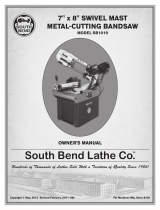 South bend SB1019 User manual
South bend SB1019 User manual
-
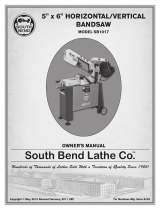 South bend SB1017 User manual
South bend SB1017 User manual
-
Grizzly G0717 User manual
-
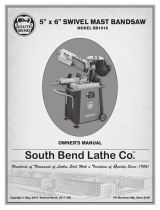 South bend sb1018 User manual
South bend sb1018 User manual
-
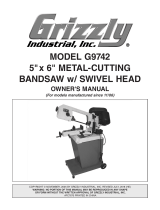 Grizzly Industrial G9742 Owner's manual
Grizzly Industrial G9742 Owner's manual
-
Grizzly G0812 Owner's manual
-
Grizzly G0561 Owner's manual
-
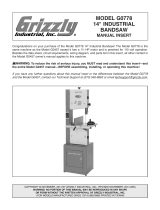 Grizzly Industrial G0778 User manual
Grizzly Industrial G0778 User manual
-
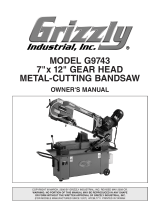 Grizzly Industrial G9743 Owner's manual
Grizzly Industrial G9743 Owner's manual
-
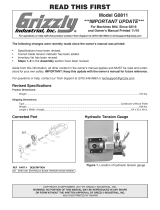 Grizzly Industrial G0811 Owner's manual
Grizzly Industrial G0811 Owner's manual
Other documents
-
Southbend SB1020 User manual
-
Wilton 63247 User guide
-
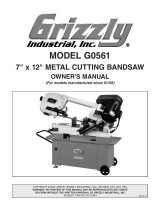 Grizzly Industrial G0561 User guide
Grizzly Industrial G0561 User guide
-
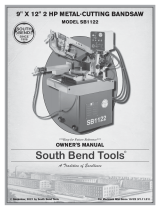 South bend SB1122 Owner's manual
South bend SB1122 Owner's manual
-
King Industrial KC-227-6 User manual
-
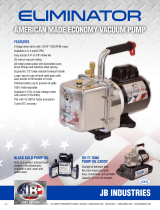 JB Industries 192303 Dimensions Guide
JB Industries 192303 Dimensions Guide
-
King Industrial KC-315CS User manual
-
King Canada KC-914H User manual
-
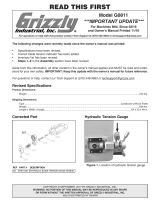 Grizzly Industrial G0811 User guide
Grizzly Industrial G0811 User guide
-
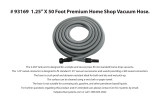 Cen-Tec Systems 92707 User manual
Cen-Tec Systems 92707 User manual



































































